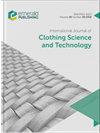Prediction of optimal 3D printing orientation using vertically sparse voxelization and modified support structure tomography
IF 1
4区 工程技术
Q3 MATERIALS SCIENCE, TEXTILES
International Journal of Clothing Science and Technology
Pub Date : 2023-08-04
DOI:10.1108/ijcst-04-2023-0041
引用次数: 0
Abstract
PurposeIncreasingly 3D printing is used for parts of garments or for making whole garments due to their flexibility and comfort and for functionalizing or enhancing the aesthetics of the final garment and hence adding value. Many of these applications rely on complex programming of the 3D printer and are usually provided by the vendor company. This paper introduces a simpler, easier platform for designing 3D-printed textiles, garments and other artifacts, by predicting the optimal orientation of the target objects to minimize the use of plastic filaments.Design/methodology/approachThe main idea is based on the shadow-casting analogy, which assumes that the volume of the support structure is similar to that of the shadow from virtual sunlight. The triangular elements of the target object are converted into 3D pixels with integer-based normal vectors and real-numbered coordinates via vertically sparse voxelization. The pixels are classified into several groups and their noise is suppressed using a specially designed noise-filtering algorithm called slot pairing. The final support structure volume information was rendered as a two-dimensional (2D) figure, similar to a medical X-ray image. Thus, the authors named their method modified support structure tomography.FindingsThe study algorithm showed an error range of no more than 1.6% with exact volumes and 6.8% with slicing software. Moreover, the calculation time is only several minutes for tens of thousands of mesh triangles. The algorithm was verified for several meshes, including the cone, sphere, Stanford bunny and human manikin.Originality/valueSimple hardware, such as a CPU, embedded system, Arduino or Raspberry Pi, can be used. This requires much less computational resources compared with the conventional g-code generation. Also, the global and local support structure is represented both quantitatively and graphically via tomographs.利用垂直稀疏体素化和改进的支撑结构层析成像技术预测最佳3D打印方向
由于其灵活性和舒适性,3D打印越来越多地用于服装的零件或制作整件服装,并用于增强最终服装的功能性或美观性,从而增加价值。许多这些应用程序依赖于3D打印机的复杂编程,通常由供应商公司提供。本文介绍了一个更简单,更容易设计3d打印纺织品,服装和其他工件的平台,通过预测目标物体的最佳方向,以最大限度地减少塑料丝的使用。设计/方法/方法主要思想是基于影子投射的类比,它假设支撑结构的体积类似于虚拟阳光的阴影。通过垂直稀疏体素化,将目标物体的三角形元素转化为具有整数法向量和实数坐标的三维像素。这些像素被分成若干组,并使用一种特殊设计的称为槽配对的噪声滤波算法来抑制它们的噪声。最终的支撑结构体积信息呈现为二维(2D)图,类似于医学x射线图像。因此,作者将他们的方法命名为改进的支撑结构层析成像。研究结果表明,该算法在精确体积下的误差范围不超过1.6%,在切片软件上的误差范围不超过6.8%。此外,对于数万个网格三角形,计算时间仅为几分钟。该算法在锥体、球体、斯坦福兔和人体模型等几种网格上进行了验证。简单的硬件,如CPU,嵌入式系统,Arduino或树莓派,可以使用。与传统的g代码生成相比,这需要更少的计算资源。此外,全球和当地的支持结构是通过层析成像定量和图形表示。
本文章由计算机程序翻译,如有差异,请以英文原文为准。
求助全文
约1分钟内获得全文
求助全文
来源期刊
CiteScore
2.40
自引率
8.30%
发文量
51
审稿时长
10 months
期刊介绍:
Addresses all aspects of the science and technology of clothing-objective measurement techniques, control of fibre and fabric, CAD systems, product testing, sewing, weaving and knitting, inspection systems, drape and finishing, etc. Academic and industrial research findings are published after a stringent review has taken place.

 求助内容:
求助内容: 应助结果提醒方式:
应助结果提醒方式:


